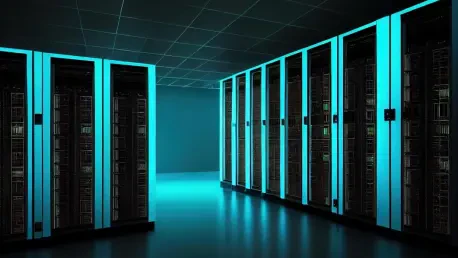What happens when the digital engines powering daily life—data centers—start draining a resource as vital as water? In the Great Lakes region, which holds one of the planet’s largest freshwater reserves, a silent crisis is unfolding as these sprawling facilities, essential for everything from streaming movies to running artificial intelligence, consume millions of gallons of water each year to keep their servers cool. This escalating demand is putting pressure on local communities, farmers, and industries already grappling with strained water supplies. The clash between technological growth and environmental sustainability demands attention before it’s too late.
The Hidden Thirst of a Digital Era
Behind every click, stream, and cloud upload lies a massive infrastructure of data centers, often out of sight but never out of impact. These facilities are the backbone of the internet age, yet their environmental footprint extends far beyond electricity bills. In regions like Minnesota, where groundwater and surface water feed both human needs and economic engines, the water consumed by data centers is becoming a critical concern. A single large facility can use as much water as 12,000 households, primarily for cooling systems that prevent servers from overheating. This staggering consumption is a wake-up call to reassess how digital progress aligns with natural resource limits.
The significance of this issue cannot be overstated. The Great Lakes region, despite its apparent abundance, faces mounting stress from climate change, agriculture, and industrial demands. Data centers are a relatively new but rapidly growing player in this equation, with their expansion driven by trends like AI and cloud computing. If left unchecked, this thirst for water could tip the balance, threatening the livelihoods of millions who depend on these shared resources. Understanding and addressing this challenge now is essential to prevent irreversible damage to a vital ecosystem.
Collision Course: Data Centers and Water Resources
The rapid proliferation of data centers across the Great Lakes region is setting the stage for conflict over water. These facilities require vast amounts of water for evaporative cooling, a process that dissipates heat by turning liquid into vapor. In Minnesota alone, proposed projects in cities like Chaska and Farmington could draw hundreds of thousands of gallons daily from already stressed aquifers. With groundwater supplying up to 40% of the Great Lakes’ volume and serving as a primary drinking source for many, the stakes are high for both urban and rural communities.
Beyond direct consumption, the strain extends to indirect impacts that ripple through the region. Even when data centers adopt water-efficient technologies, such as closed-loop cooling, they often demand more electricity to power pumps and fans. This increased energy need burdens thermal power plants—coal, gas, or nuclear—that themselves require substantial cooling water, creating a hidden water footprint. The result is a complex web of resource demands that challenges the notion of water abundance in this freshwater-rich area.
Deep Dive into a Growing Water Crisis
Examining specific cases reveals the severity of the issue at a granular level. Take Meta’s planned $800 million facility in Rosemount, Minnesota, which is projected to draw 100,000 gallons of groundwater daily—enough to fill an Olympic swimming pool every six days. Such numbers highlight how a single data center can rival the water needs of entire neighborhoods, raising questions about long-term sustainability in areas already facing depletion risks. Local officials often claim capacity exists, but the lack of comprehensive data adds uncertainty to these assurances.
Conflicts over water are not just theoretical; they are already playing out in real time. In early 2025, the Minnesota Department of Natural Resources had to step in with restrictions on irrigation along certain creeks due to evidence of groundwater harm. These measures, while necessary, underscore the growing tension between competing users—farmers, industries, and now tech giants. As more facilities are proposed, the pressure on aquifers intensifies, threatening the delicate balance of surface and underground water systems that millions rely on for survival.
Voices from the Ground: Policy and Community Perspectives
Experts and locals alike are sounding the alarm on this escalating crisis, bringing human and political dimensions to the forefront. Helena Volzer, a water policy manager for the Alliance for the Great Lakes, describes the situation as a “shell game,” where reducing water use in one area often shifts the burden elsewhere. She argues for stronger groundwater protection laws in Minnesota, urging policies that allow preemptive action when impacts are likely, rather than waiting for proven damage. Her insights point to a need for proactive, rather than reactive, governance.
Community frustration adds another layer of urgency to the debate. In areas near large data center projects outside Minnesota, such as a Meta facility in Georgia, residents have reported undrinkable well water, sparking outrage and distrust. Closer to home, Minnesota State Rep. Rick Hansen critiques the slow pace of water policy reform, pointing to powerful agricultural lobbying—termed “cropaganda”—as a barrier to progress. These voices collectively illustrate how the water strain from data centers is not just a technical problem, but a deeply personal and political one that demands inclusive dialogue.
Mapping Solutions for a Sustainable Digital Future
Finding a balance between digital expansion and water conservation requires innovative strategies tailored to the Great Lakes region. One critical step is policy reform, such as expanding Minnesota’s groundwater laws to intervene before crises emerge. Experts like Volzer also advocate for increased funding for water demand studies, which would equip authorities with better data to guide data center placements and mitigate aquifer stress. These measures could set a precedent for other states facing similar challenges.
Transparency must also play a central role in addressing this issue. Stricter reporting requirements for water use by data centers can break through the nondisclosure barriers often seen between developers and cities. Additionally, incentivizing technological advancements, such as waterless cooling systems paired with renewable energy sources like wind and solar, offers a dual benefit of reducing both direct water use and indirect energy-related water footprints. Engaging local communities in decision-making processes further ensures that their concerns are heard, fostering trust and collaboration in planning sustainable growth.
Looking back, the journey to address the water strain caused by data centers in the Great Lakes region revealed a complex interplay of technology, policy, and community needs. Reflecting on the challenges faced, it became evident that actionable steps were not just necessary but urgent. Moving forward, stakeholders were encouraged to prioritize integrated water-energy planning, pushing for legislative updates by 2027 to safeguard aquifers. Investing in cutting-edge cooling technologies and fostering open dialogue with residents emerged as key pillars for a balanced future. These efforts, if sustained, promised to harmonize digital innovation with the preservation of a resource too precious to lose.









